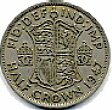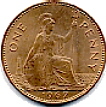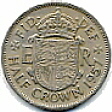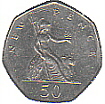|
|
 |
| This is a pre-decimal
version with five tubes to hold two-shillings,
two tubes of shillings, sixpences and
threepenny bits. |
 |
| This design of
change-giver allowed tubes to be added
or removed and the order to be changed
according to the coins in use at the
time. |
|
|
| Coins
Included |
     |
| |
 |
| Other
Coins |
   |
|
|
 |
 |
 |
|
|
 |
| This is a pre-decimal
version with six tubes to hold half-crowns,
two-shillings, shillings, two tubes
of sixpences and one of threepenny bits. |
 |
| Pennies and halfpennies
were not included. Drivers on Hants
& Dorset continued to carry a conductor's
cash bag to hold these and their fare
charts and timetables. |
 |
| Coins often remained
in circulation for many years. As a
result, there were several different
designs of each around at any time. |
|
|
| Coins
Included |
    |
  |
 |
| Other
Coins |
  |
|
|
 |
 |
 |
|
|
 |
| An unusual design,
this is a pre-decimal version with seven
tubes. Three tubes hold threepenny bits
and the other four hold sixpences. The
tubes are set to give different quantities
of coins, for instance four sixpences
for a two shilling coin or five for
a half-crown.. |
 |
|
|
|
|
| The first two tubes give a
single 3d and the third gives two. The next gives
a single 6d, then there are two tubes giving four
and the last gives five. This type of machine was
used to give change for larger coins on London Transport
Red Arrow and other flat-fare buses introduced in
the 1960s. The passenger was given the whole amount
and then put the required coins into a turnstile
or Auto-fare slot. |
 |
 |
 |
|
|
 |
| This decimal version
with six tubes held pennies, two lots
of two pence pieces, two of the original
shilling size five pences and one of
the original two shilling size ten pence
pieces. |
 |
| The five and ten
pence coins were later replaced by smaller
ones, as was the fifty pence piece.
The old sixpence was retained as a two
and a half pence piece for a while after
decimalisation as many slots would need
to be replaced. |
 |
|
|
| Coins
Included |
   |
  |
 |
| Other
Coins |
   |
|
|
| The pound and twenty pence
pieces were introduced a few years after decimalisation. |
 |
 |
 |
|
|
 |
| This version holds
from left to right: £1, 50p, 20p,
10p, 5p, 2p, and 1p using the later,
smaller versions of 50p, 10p and 5p. |
 |
| The new halfpenny
and old sixpence were taken out of circulation
around 1980. The penny and two pence
coins no longer have the word NEW. The
20p coin was introduced in 1982 followed
by the pound coin in 1983, the new 5p
in 1990 and the new 10p in 1992. |
 |
|
|
| Coins
Included |
   |
    |
 |
| Other
Coins |
 |
|
|
| The smaller 50p did not arrive
until 1998, together with a £2 coin. |
 |
 |
 |
|
|
 |
| This Syro machine
holds from left to right: 50p, 10p,
5p, 2p, 1p, and 20p also using the later,
smaller versions of 50p, 10p and 5p. |
|
|
|
|
 |
| The 10p lever has been replaced
by one marked 50p. |
 |
 |
 |
| Drivers on Hants & Dorset
pay-as-you-enter buses and many other companies
were issued with a change machine. Each tube had
the diameter to hold a coin of a different value.
The tubes can be changed to take different combinations
of coin. The change giver was clipped to the cab
door, allowing coins to be dropped in from the cash
tray which had matching slots. |
 |
| The change to decimal currency
took place on Monday 15th February 1971. The 10p
and 5p coins had been introduced in 1968 to allow
people to become used to them. The 50p piece arrived
in the following year to replace the ten shilling
note. The (old) halfpenny was withdrawn at this
time and the half crown in 1970. The old sixpence
remained in use as 2½p until about 1980.
The old shilling (5p) and two shilling (10p) coins
gradually disappeared in the years following decimalisation
and finally with the introduction of the smaller
versions of the decimal coins. The 20p coin was
introduced in 1982 and the £1 coin in 1983. |
 |